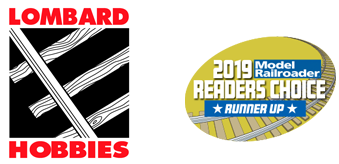ScaleTrains HO
ScaleTrains Museum Quality HO SXT70102 DCC Ready EMD SD45X Southern Pacific 'Ex-EMD Patch' SP #9505
- In Stock:
- 1
- Scale:
- HO
- SKU:
- SXT70102
Description
Please note picture is representative of the item but may not be same road number. Always refer to product description for actual product details.
ScaleTrains Museum Quality HO SXT70102 DCC Ready EMD SD45X
Southern Pacific 'Ex-EMD Patch' SP #9505
Road Number Specific ScaleTrains
- All-new model
- Era: 1973 to mid-1970s
- Series SP 9503-9505; ex-EMD 4201-4203, built 6/1970
- Fully-assembled
- LED-illuminated ground lights on both sides of locomotive*
- LED-Illuminated rectangular walkway lights mounted between front sanding valve doors, and round walkway light aft of raised walkway duct*
- LED-illuminated Pyle-National (Translite) #20585 “Gyralite” dual signal light mounted in number board housing*
- LED-illuminated tricolor flush-mounted front class lights with raised gaskets, and stand-off rear class lights mounted on angled housings
- LED-illuminated cab interior and control stand lighting*
- Printed number boards with separately-controlled, backlit LED-illumination*
- Tall “Western” style pilot plow with grab irons, front and rear
- 4-hose multiple unit (MU) hose clusters with silver gladhands
- Semi-scale coupler buffers equipped with durable metal semi-scale Type E knuckle couplers
- Front and rear angled uncoupling levers without loop handles
- Deck-mounted multiple unit (MU) receptacle on front, and pilot face mounted multiple unit receptacle on rear
- "Tall" stepwells with see-through steps on front, and Tunnel Motor-style rear “ladder” steps
- Front early small deck extension, and full-width anticlimber on rear
- End handrails with pilot face mounted outer and deck-mounted inner stanchions on front, and Tunnel Motor-style rear full-width anticlimber deck-mounted stanchions
- Front standard drop step
- Scale sectioned treadplate detail on walkways
- 88” low short hood (81” with 7” extension ahead of cab) with ratchet handbrake and angled chain guard, right side
- Latched battery box doors with narrow louvers and tab-style (early) hinges
- Early SP “split” cab sub-base doors (tab-style hinges)
- SP-style nose headlight package: horizontally-mounted dual sealed-beam standard headlight, with a single red Pyle-National (Translite) #17540 Gyralite signal light mounted in recess above
- Early “Dash-2”-style cab with 11-bolt (top and bottom) side window panels, large armrests on both sides, long rear roof overhang, front cab heater/blower extension (right side), and L-shaped front engineer’s window
- Rectangular vent towards front of cab, both sides, and rectangular vent on both sides of cab rear
- Detailed cab interior with separate floor, rear wall, seats, and standard AAR control stand
- Sliding cab side windows
- Tall angled-corner clear wind wings mounted fore and aft of cab side window, both sides of cab
- Standard EMD sunshades with long sunshade tracks
- Lost-wax cast brass Nathan P3 (P24R1) horn mounted on number board housing
- “Whip” antenna base mounted to right rear of cab roof
- Standard SD45X long hood with accurate door and latch details
- Early inertial air intake grilles without drip rails
- SD45X-style wide turbo exhaust stack
- Accurately-profiled extended-range dynamic brake housing with large “shoebox” vent at rear
- See-through 48” dynamic brake fan housings with 9-blade fan and hub detail visible inside
- See-through dynamic brake intakes with resistor grid detail behind the intake vanes
- FARR Air-brand radiator intake grills
- Four see-through standard 48” radiator fan housings with 9-blade fan and hub detail visible inside
- Curved radiator fan grab iron
- Radiator core water spray system pipe between #2 and #3 radiator fans
- Underbody frame rails with separately-applied plumbing and traction motor cable bundle details
- Early Rockwell-cast (“wreath” logo) HT-C truck frames, Hyatt bearings, intermediate center axle snubbers (reinforcing webs at bearing mount), sanding lines, and gearbox with individual D77 traction motor and air duct details
- Dimensionally accurate truck centers
- Early EMD speed recorder with adapter flange mounted to left #1 axle
- Handbrake chain, chain pulley, and tension spring details on right sidesill, under the cab
- Separately-applied brake cylinders in released (piston retracted) position
- Tall jacking pads with holes
- Cab-roof “tripod” mount bell with air conduit
- Graham-White (Salem) brand 824-170 and 818-170 primary and secondary centrifugal air filters, respectively (accordion-style)
- 4,400-gallon fuel tank with fuel fillers front and rear, vertical gauges front and rear, round gauges in tank sides, and “Y-branch” dual vertical breather pipes
- Factory-applied wire grab irons, wire lift rings, windshield wipers, trainline hoses, sand hatch covers, and more
- Motor with 5-pole skew-wound armature
- Dual flywheels
- All-wheel drive
- All-wheel electrical pick-up
- Directional LED headlights
- Printing and lettering legible even under magnification
- EMD Demo scheme metallic blue color matched to TCP-259 EMD Demo Blue
- Operates on Code 70, 83, and 100 rail
- Packaging safely stores model
- Minimum radius: 22”
- Recommended Radius: 24”
DCC & sound equipped locomotives also feature:
- ESU LokSound 5 DCC & Sound decoder with “Full Throttle” functions
- Two (2) cube-type speakers
- Turbocharged EMD 20-645 prime mover sounds
- Curve squeal and frog clank sounds*
- ESU designed “PowerPack” with two super capacitors***
- Operates on both DC and DCC layouts*****
DC/DCC & sound ready locomotives also feature:
- Operates on DC layouts*****
- DCC-ready with 21-pin connector
* These features only function with an ESU DCC decoder installed while operating in DCC
** Class lights illuminate in white color only in DC operation. Access and changing colors an ESU decoder with appropriate programming while operating using DCC
*** “PowerPack” feature only compatible with appropriately programmed ESU decoders operating on a DCC layout
*****Lombard Hobbies Recommendation - As modelers ourselves we highly recommend ONLY running DCC on DCC systems and DC on DC systems, regardless of 'Dual-Mode' capability. This gives optimum performance and safeguards the unit from possible damage from running on a different system than originally intended and from any inexperienced operator errors.
Prototype History:
“Bigger is Better” is an apt description for EMD’s SD45X, the locomotive powerhouse of the 1970s. Built on their longest single-engine platform at the time with an unprecedented 4,200hp out of its 20-cylinder 645-series prime mover, the SD45X became a signature locomotive of the Southern Pacific Railroad.
EMD ultimately built a total of seven (7) units. The first unit, EMD no. 5740, was, aside from the L-window on the right-side cab face, built as a “Plain Jane '' demonstrator that would tour railroads all over the country. Three more demonstrators, EMD 4201 through 4203, followed shortly afterward, and were distinctive in being built to Southern Pacific specifications: large snowplows mounted to the front and rear pilot faces, SP’s trademark Gyralite signal light package on the front end, class lights on the rear, cab L-window, and a tripod-style mount bell on the cab roof. Seeing as SP was the largest SD45 owner, and was constantly pressing EMD to make improvements to the model, it was fitting that those demonstrators were built with SP in mind. To that end, SP would also buy three units outright, numbered SP 9500-9502, entering service in September 1970. After delivery and initial setup at SP’s Los Angeles Taylor Yard, they were quickly sent north to what would be their maintenance home base for the rest of their careers, SP’s massive Roseville Yard in Northern California.
The demonstrator units, in their striking white and EMD metallic blue paint, toured other railroads for testing purposes such as Illinois Central and Santa Fe. However, they would spend the majority of their time on the SP, testing their new technology on the road’s rugged operating environment. The demos and SP’s own units could be found in all kinds of assignments, with sets of SD45Xs grinding up Donner Pass being a common sight. Despite the design innovations and lessons learned from the SD45, the SD45Xs had their share of teething issues. One issue that had plagued SP for decades was locomotives overheating on their grueling mountain grades, and despite the massive radiator and four fans, the SD45Xs experienced overheating issues as well.
As a test, in late 1970 EMD and SP techs installed sheet metal airfoils over the radiator intakes, in an attempt to direct a larger volume of cooling air through the radiator cores. Between November 1970 and March 1971, four SD45Xs – SP 9500 and 9501, and EMD 4201 and 4203 – went into Roseville shops to have these appliances installed for test runs over the Sierras and Cascades. Similar airfoils were also applied to a few members of SP’s SD45 fleet. From data gathered from the tests, while the airfoils helped to a degree, they weren’t the definitive solution, which would ultimately be found with the introduction of another uniquely-SP locomotive type in 1972: the SD45T-2, the first of the famed “Tunnel Motor” line.
Once their data-gathering days were over, EMD would sell the SP-spec demos 4201-4203 to Southern Pacific in December 1972. They were renumbered after SP’s own units. EMD 4202-4203 would be “patched” to SP 9504-9505 in 1973, retaining their EMD demo blue and white colors, but with their EMD logos and road numbers erased and replaced with SP-style road numbers and the recently-introduced 21” sans-serif “SP” nose logo. They would operate for some time in this configuration before being repainted into full SP colors. EMD 4201, on the other hand, evidently went straight from EMD demo colors to a full repaint as Southern Pacific no. 9503 in the Summer of 1973.
The SD45Xs settled into a mundane existence on the SP, freely mixed with other road power of the time, and usually found on heavy mainline freights out of their home base in Roseville. However, the small fleet size and mechanical oddball status earned them no favors on the SP, and by June 1984, all were retired and eventually scrapped. Interestingly, the EMD-spec demo, 5740, was to enjoy a somewhat longer career, lasting well into the 1990s in the EMD testbed fleet. At some point in the late 1980s it received some unique upgrades, including having its radiator fans replaced with 48” Q-Fans, a rectangular exhaust silencer housing replacing its original straight turbo exhaust, and a fresh coat of EMD “Oakway” scheme blue and white paint. Reportedly, it was to have been rebuilt to SD40-2 internal specifications for an extended career as a lease fleet unit, but under mysterious circumstances, would find itself cut up for scrap by the early 2000s, ending the story of the SD45X. It was a unique model that despite its limited numbers, made a lasting impression and introduced technology that was to change the face of railroading for decades to come.
Lombard Hobbies - Your #1 Largest Authorized ScaleTrains Select Retailer!






















